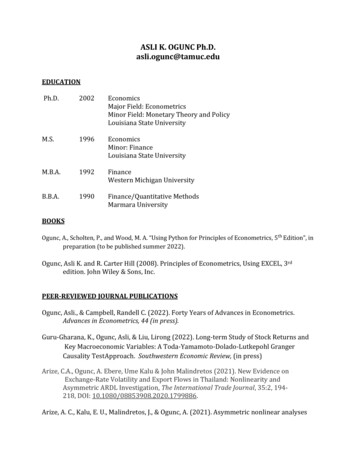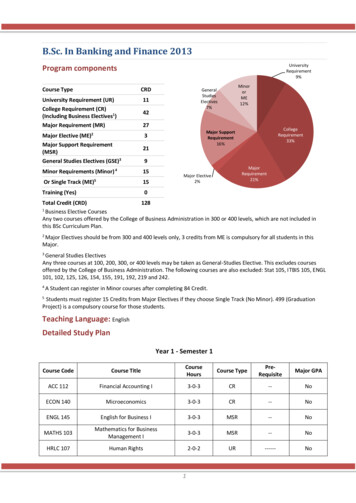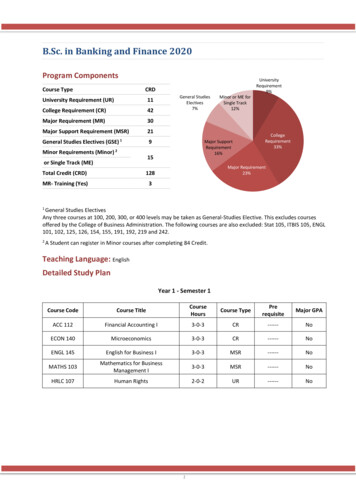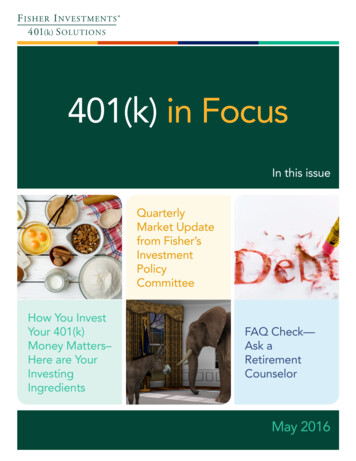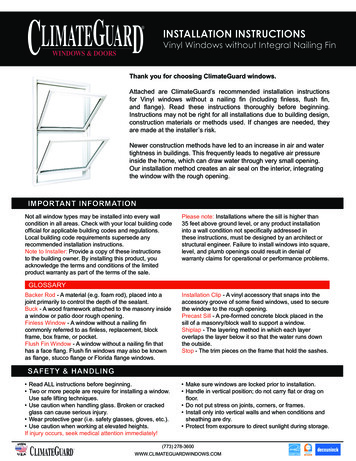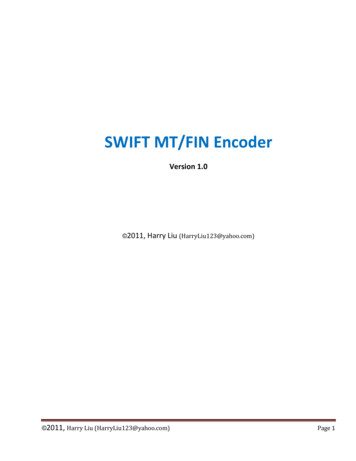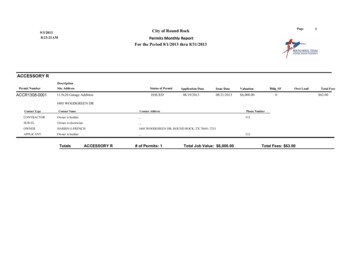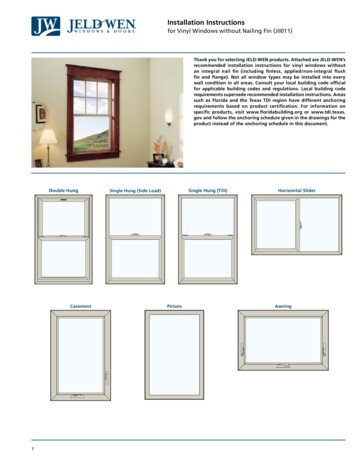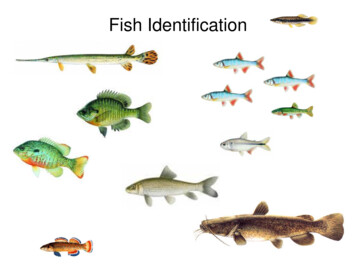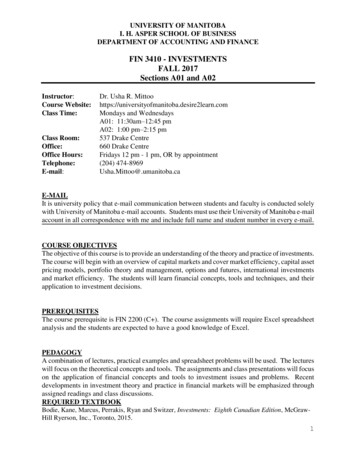
Transcription
UNIVERSITY OF MANITOBAI. H. ASPER SCHOOL OF BUSINESSDEPARTMENT OF ACCOUNTING AND FINANCEFIN 3410 - INVESTMENTSFALL 2017Sections A01 and A02Instructor:Course Website:Class Time:Class Room:Office:Office Hours:Telephone:E-mail:Dr. Usha R. mMondays and WednesdaysA01: 11:30am–12:45 pmA02: 1:00 pm–2:15 pm537 Drake Centre660 Drake CentreFridays 12 pm - 1 pm, OR by appointment(204) 474-8969Usha.Mittoo@.umanitoba.caE-MAILIt is university policy that e-mail communication between students and faculty is conducted solelywith University of Manitoba e-mail accounts. Students must use their University of Manitoba e-mailaccount in all correspondence with me and include full name and student number in every e-mail.COURSE OBJECTIVESThe objective of this course is to provide an understanding of the theory and practice of investments.The course will begin with an overview of capital markets and cover market efficiency, capital assetpricing models, portfolio theory and management, options and futures, international investmentsand market efficiency. The students will learn financial concepts, tools and techniques, and theirapplication to investment decisions.PREREQUISITESThe course prerequisite is FIN 2200 (C ). The course assignments will require Excel spreadsheetanalysis and the students are expected to have a good knowledge of Excel.PEDAGOGYA combination of lectures, practical examples and spreadsheet problems will be used. The lectureswill focus on the theoretical concepts and tools. The assignments and class presentations will focuson the application of financial concepts and tools to investment issues and problems. Recentdevelopments in investment theory and practice in financial markets will be emphasized throughassigned readings and class discussions.REQUIRED TEXTBOOKBodie, Kane, Marcus, Perrakis, Ryan and Switzer, Investments: Eighth Canadian Edition, McGrawHill Ryerson, Inc., Toronto, 2015.1
OTHER RESOURCESClass notes, End-of-Chapter Solutions and additional readings will be available throughUMLearn(D2L). Students should read the assigned material prior to its coverage in class. TheEnd-of-Chapter questions and problems from the textbook and other reading materials will beassigned weekly. Students are strongly advised to work on these assignments independently and tocorrect their own solutions with the text-book solutions. Students will also be required to useBloomberg and internet sources for articles and data collection for their assignments andpresentations.McGraw-Hill Ryerson’s Online Learning Centre (OLC): McGraw-Hill Ryerson has an excellentOnline Learning Centre for the 7th edition of the required text. For every chapter in the book, thissite includes a chapter overview, YouTube Videos, multiple-choice quizzes, and web links. Pleasetake advantage of this useful site. The URL of the Online Learning Centre 5/student view0/index.htmlThe ETF Global Portfolio Challenge:All students will participate in the ETF Global Portfolio Challenge, a web-based simulatedinvestment challenge designed to serve as a fun and educational tool intended to help educatestudents about investing in Exchange-Traded-Funds (ETFs). Through this website, investorswill construct a portfolio utilizing between four and ten ETPs using a virtual endorsement of onehundred thousand dollars ( 100,000). Players will attempt to pick the top-performing portfoliosof ETFs. Each participant will compete on the investment performance of their respective virtualportfolio. The sign-up and game navigation instructions can be found under the "How It Works"section of the contest website - www.etfportfoliochallenge.comFor doing research on ETFs, students may register for their free trials to Etfg’s research platformusing the promo code ETFGPCF2016 - https://www.etfg.com/signup and use the videotutorials - http://www.etfg.com/tutorials - to learn how to leverage the various features of thewebsite for research purposes.The students will be required to write a written report and make a class presentation (10%) basedon their investment strategy and lessons learnt from the ETF Global Portfolio Challenge on agroup basis. While each student will register in the game individually, students should worktogether in groups of two to three students for preparing the report and presentation.Important note: The registration for the challenge ends on September 22, 2017. The challengeruns from Sept.25 to Dec.8, 2017. Students who are placed in the top 25 performers will get up to 5bonus marks based on their individual relative rankings in the challenge.2
GRADING AND EXAMINATIONSFinal grades are based on the student’s weighted mark and performance relative to other students.EVALUATIONClass ParticipationMid-term ExaminationAssignmentsClass Presentation (The ETF Portfolio Challenge)Final ExaminationTotal5%30%10%10%45%100%ATTENDANCE POLICYClass attendance is required. Students can miss up to two classes during the term without penalty.All further absences over this limit will reduce the student’s participation grade. Habitual latenessand leaving class early will be noted as evidence of low course commitment and penalized.CLASS PARTICIPATION/CONTRIBUTIONAttendance and class participation will be extremely beneficial towards understanding the coursematerial, while earning points towards your grade. To earn the marks for participation, show yourname plate on the table in every class and try to answer the questions asked by the professor. It isimportant that you be an active contributor to class discussion. Class participation grade will dependon both the quantity and quality of your class contributions.ASSIGNMENTS AND PRESENTATIONSAssignments and presentations will be done on a group basis with two to three students in a group.ASSIGNMENTSThe main objectives of the assignments are to learn the application of Excel in estimating risk andreturn, selecting optimal portfolios, and regression analysis using real market data. Only oneassignment per group should be submitted.LAB SESSIONSThis course will incorporate one or two in-class computer lab sessions that are designed to teachapplication of the portfolio theory and single index models using Microsoft Excel. The Lab sessionswould be very helpful in doing assignments and presentations. The outline lists the tentative datesfor these sessions.Important: The attendance in Lab sessions is mandatory. Students are responsible to sign the labattendance sheets. For the lab session, students are required to bring a laptop computer ready withMicrosoft Excel.3
CLASS PRSENTATIONThe presentation is based on the students’ experience in the ETF Global Portfolio Challenge ona group basis. The presentation is group work and members of each group should work togetheron the presentation.The main objective of the presentation is to demonstrate knowledge and understanding ofinvestment concepts, knowledge and tools learned in the class using real market data andanalysis. The students are encouraged to experiment with different investment strategies toenhance their learning from the portfolio challenge. The students will be required to write awritten report and make a class presentation (10%) based on their investment strategy and lessonslearnt from the ETF Global Portfolio Challenge on a group basis. While each student willregister and compete in the game individually, students should work together in groups of two tothree students in a group for preparing the report and presentation.The group presentation will be about 8-10 minutes. The presenting group must email the professortheir PowerPoint presentation slides and the summary report that provides a brief description of theirstrategy, information sources, and data analysis used in the presentation one day prior to theirscheduled presentation.Important: All students are required to be present in the class for all presentations. Theprofessor will schedule the dates of presentations for each group.EXAMINATIONThe midterm exam will take place on Monday, October 30, 6:00 pm to 8:00 pm (Room 343 Drake).There will be no make-up mid-term examination. Students who miss the mid-term exam and have avalid medical excuse will have the weight of the mid-term added to the final examination. Studentswith valid medical excuses must obtain a doctor's certificate that the student's condition is severeenough to prevent the student from taking the examination. Students who miss the midterm examwithout a valid medical excuse will receive a grade of zero on the mid-term examination.Both mid-term and final exams will be closed book except as follows: a one-sided 8.5" x 11" sheetwith anything hand written on it can be taken into the mid-term and a two-sided 8.5" x 11" sheetcan be taken into the final. Formula sheets must be hand written. No word-processed orphotocopied material is allowed on your formula sheet. Improper formula sheets will be confiscated.The use of laptops and mobile phones is not permitted during the exams. You can bring a financialcalculator, but in the event that your calculator is programmable you may not enter any text,formulae, or data. Note: the final exam is cumulative.4
DATETENTATIVE COUSE OUTLINETOPICSeptember 11-131. The Recent History of Investing and theInvestment ObjectiveEnrollment in ETFPortfolio Challenge 2. Financial Markets and InstrumentsSeptember 18-20September 22 Deadline for ETFPortfolio ChallengeregistrationSept. 25- Oct. 4October 23. How Securities are Traded4. Risk and ReturnCHAPTER1, 2345. Capital Allocation to Risky Assets, Optimal Risky5, 6PortfoliosLAB I: Estimating the Markowitz Frontier and theCapital Market Line (CML)Term break-Oct 5,6 October 11(Lab I) Assignment 1- DueThanksgiving-Oct 9Monday- no classOctober 11-167. The Capital Asset Pricing Model8. Index ModelsOctober 16LAB II: Estimating the Single Index ModelOctober 23 (Lab II) –Assignment 2 Due78October 189. Factor Models and the Arbitrage Pricing Theory10. Empirical Evidence on Security Returns911October 23-2511. Managed Funds23October 30No classOffice hours:12:00-1:30 pmNovember 1 - 8No Class- Nov. 11Remembrance dayNovember 13-22MID-TERM EXAM (30%)Drake Centre: Room 3436:00 pm to 8:00 pm11. Futures and Forward Markets12. International Investing20241819November 27-2913. Options and other DerivativesOption Strategies and PayoffsOption Pricing ModelsClass PresentationsDecember 5-714. Market Efficiency95
AACSB Assurance of Learning Goals and Objectives.The Asper School of Business is proudly accredited by AACSB. Accreditation requiresa process of continuous improvement of the School and our students. Part of“student improvement” is ensuring that students graduate with the knowledge andskills they need to succeed in their careers. To do so, the Asper School has set thelearning goals and objectives listed below for the Undergraduate Program. Thechecked goal(s) and objective(s) will be addressed in this course and done so bymeans of the items listed next to the checkmark.Goals and Objective in the Undergraduate Program1 Entire course Entire course AssignmentsB.Use correct English grammar and mechanics in their writtenwork.Communicate in a coherent and logical manner C.Present ideas in a clear and organized fashion. WrittenassignmentsClass presentation Chapter 1Chapter 1 Entire courseB.C.Ethical ThinkingA.B.C.D.4Determine which quantitative analysis technique is appropriatefor solving a specific problem.Use the appropriate quantitative method in a technicallycorrect way to solve a business problem.Analyze quantitative output and arrive at a conclusion.Written CommunicationA.3Course Item(s)Relevant tothese Goalsand ObjectivesQuantitative ReasoningA.2Goals andObjectivesAddressedin thisCourseIdentify ethical issues in a problem or case situationIdentify the stakeholders in the situation.Analyze the consequences of alternatives from an ethicalstandpoint.Discuss the ethical implications of the decision.Core Business Knowledge6
Academic IntegrityIt is critical to the reputation of the Asper School of Business and of our degrees that everyone associated with our facultybehave with the highest academic integrity. As the faculty that helps create business and government leaders, we have aspecial obligation to ensure that our ethical standards are beyond reproach. Any dishonesty in our academic transactionsviolates this trust. The University of Manitoba General Calendar addresses the issue of academic dishonesty under theheading "Plagiarism and Cheating". Specifically, acts of academic dishonesty include, but are not limited to:-using the exact words of a published or unpublished author without quotation marks and without referencing thesource of these words-duplicating a table, graph or diagram, in whole or in part, without referencing the source-paraphrasing the conceptual framework, research design, interpretation, or any other ideas of another person,whether written or verbal (e.g., personal communications, ideas from a verbal presentation) without referencing thesource-copying the answers of another student in any test, examination, or take-home assignment-providing answers to another student in any test, examination, or take-home assignment-taking any unauthorized materials into an examination or term test (crib notes)-impersonating another student or allowing another person to impersonate oneself for the purpose of submittingacademic work or writing any test or examination-stealing or mutilating library materials-accessing tests prior to the time and date of the sitting-changing name or answer(s) on a test after that test has been graded and returned-submitting the same paper or portions thereof for more than one assignment, without discussions with theinstructors involved.Group Projects and Group WorkMany courses in the Asper School of Business require group projects. Students should be aware that group projects aresubject to the same rules regarding academic dishonesty. Because of the unique nature of group projects, all groupmembers should exercise special care to insure that the group project does not violate the policy on Academic Integrity.Should a violation occur, group members are jointly accountable unless the violation can be attributed to a specificindividual(s).Some courses, while not requiring group projects, encourage students to work together in groups (or at least do notprohibit it) before submitting individual assignments. Students are encouraged to discuss this issue as it relates toacademic integrity with their instructor to avoid violating this policy.In the Asper School of Business all suspected cases of academic dishonesty are passed to the Dean's office in order toensure consistency of treatment.7
The ETF Global Portfolio Challenge: All students will participate in the ETF Global Portfolio Challenge, a web-based simulated investment challenge designed to serve as a fun and educational tool intended to help educate students about investing in Exchange-Traded-Funds (ETFs). Through this website, investors
